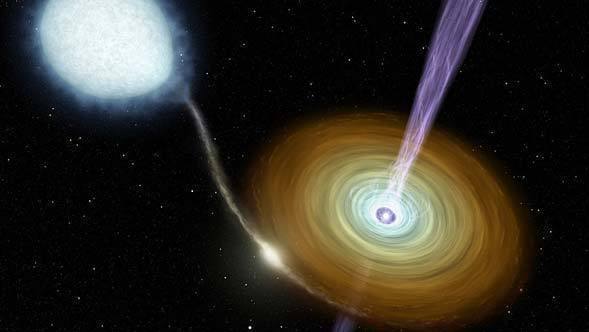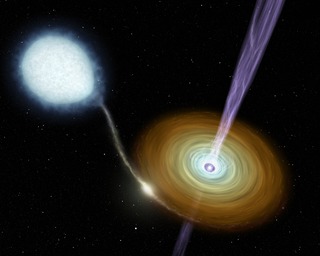
Credit: NASA/JPL-Caltech/R. Hurt (SSC)
Artwork • May 22nd, 2006 • sig06-014
sig06-014
This artist concept illustrates jets of material shooting out from the neutron star in the binary system 4U 0614+091. Astronomers using the Spitzer Space Telescope found these remarkable jets, which are streaming into space at nearly the speed of light. Until this observation, astronomers thought that the ability to shoot such continuous jets into space was unique to black holes.
The 4U 0614+091 system contains two stellar corpses, remnants of long-dead stars. The larger one (upper left) is the surviving core of a sun-like star, known as a "white dwarf." The smaller neutron star (lower right, at center of disk) is the dead core of a much more massive star that once exploded in a supernova. Even though the neutron star is tiny compared to the white dwarf it is incredibly dense and is actually about 14 times more massive!
The white dwarf orbits the neutron star similar to the way the Earth orbits the sun. Like a cosmic vacuum cleaner, the neutron star's intense gravity picks up material leaving the white dwarf's atmosphere and collects it into a disk around itself. Known as an "accretion disk," the collected material orbits the neutron star similar to the way rings circle Saturn. The accretion disk is much denser than Saturn's rings, however, and under the influence of the neutron star's immense gravity the inner portions are heated to incredible temperatures.
How the jets around the neutron star are created remains a mystery, but scientists note that accretion disks and intense gravitational fields are characteristics that both neutron stars in binary systems like this one and black holes share. They believe that these traits may be all that is needed to form and fuel the continuous jets of matter.
About the Object
- Name
- 4U 0614+091
- Type
- Star > Grouping > Binary
- Star > Evolutionary Stage > Neutron Star
- Star > Circumstellar Material > Disk
- Star > Evolutionary Stage > White Dwarf
- Distance
- 10,000 Light Years





